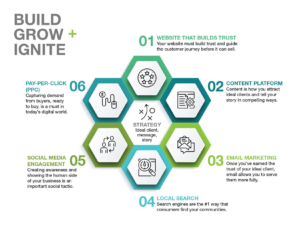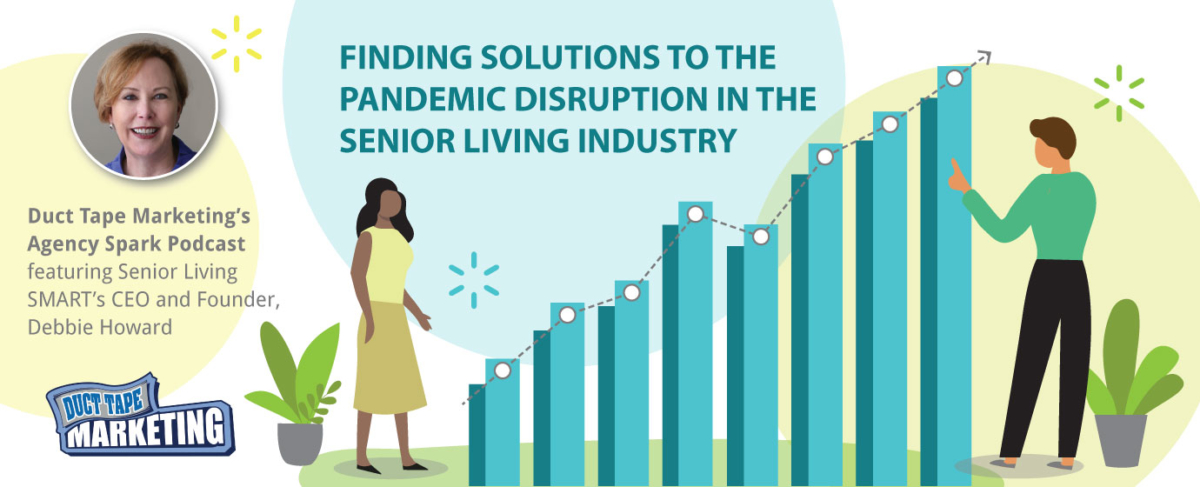How to Create an Effective Senior Living Marketing Strategy
Are you wondering how to create an effective senior living marketing strategy that’s easy to justify to the C-suite and will boost occupancy too? Step right up! We got you.
First, picture your marketing as a hub with your ideal prospect in the center. Then, around the hub, picture six spokes:
- Website
- Content
- Search
- Social Media
- Paid Ads
Below, we’ll discuss each component, starting with your ideal prospect. (Are you more of a visual learner? Check out this video explanation.)
Understand your ideal prospect (a.k.a. develop strong buyer personas)
Personas are fictional representations of your ideal customers—in this case, your ideal residents and the adult children and loved ones involved in making decisions. Armed with a clear picture of your buyers, you can better personalize your messaging and marketing.
For example, instead of sending the same lead nurturing emails to everyone in your database, you can segment by prospect persona and tailor the messaging accordingly.
Keep in mind that personas are internal documents. Marketing and sales teams use them to guide the development of various messaging and marketing campaigns.
How do you create effective personas?
You create buyer personas through research, surveys, and interviews with happy residents and, ideally, lost prospects. Here are some practical methods for gathering the information you need:
- Interview happy residents. What made them move into senior living? Why your community? What problem did your community solve for them? Note: The “problem” isn’t necessarily going to be negative. It could be positive, like “I was ready to downsize and enjoy maintenance-free living and an active lifestyle.”
- Gather demographics for each level of care. What’s the average age, the breakdown between women and men, marital status, etc.?
- Review resident surveys. What services and amenities do your residents find most valuable?
- Talk to lost prospects. Why did they choose a different community?
- Gather intel from your website forms. What are the person’s hobbies? Take advantage of progressive fields in forms, which allow you to ask different questions as people download more content from your site.
- Talk to your sales team. What generalizations can they make about the different types of residents and prospective residents you serve best? What are the most frequent questions they answer?
What should you do with the persona research?
Create a one-page narrative about each persona. Give the persona a real name. Use images to bring the persona to life even more. (In this case, stock images are acceptable.)
For example, you might craft narratives about “Widowed Wally” and “Single Sally” that explain who they are, their needs/pain points, and what they hope to find in a senior living community. The needs of widowed men between 70 and 85 (“Widowed Wally”) will be different from single women in their 60s (“Single Sally”).
Remember, even though these are fictional representations, your personas are based on genuine facts uncovered in your research. In other words, your personas will differ from another community’s, and your personas will help you identify what makes your community different. The latter is called your unique value proposition.
The other six components of your marketing strategy “hub”
1. A website that builds trust
Your senior living website is your most important marketing asset, one that must build trust with prospects no matter where they are in their journey.
So, what’s the number one reason most people mistrust a website? Poor site design.
Luckily, your website’s design is something within your control. A good design does cost money, but it’s a worthy investment. (Remember that you’ll need to refresh—or possibly do a full-scale redesign—every three years or so.)
The secret sauce to a website that builds trust:
- Aesthetically pleasing: A modern and clean design with custom photography and video (no stock images)
- Technically sound: Mobile-friendly, fast, and accessible to all
- Designed with the user in mind: Think simple navigation and a highly intuitive feel
- Worthwhile content: Everything is written with the prospect in mind while still being optimized for improved search ranking
- Thoughtful conversion strategy: Smartly designed calls-to-action (CTAs), landing pages, chat, surveys, and pop-ups help convert anonymous site visitors into leads
Successful senior living websites should have roughly 75 percent new visitors (and 25 percent returning visitors).
2. Content that your buyer personas crave
Compelling content will attract your ideal prospect and entice them back repeatedly. This is important considering how long the senior living sales cycle is—and how many “touchpoints” prospects require before they decide on a community.
Some estimates indicate it now takes over 100 days for memory care prospects and a whopping 400 days for people considering life plan communities (with assisted living and independent living falling in the middle).
The best content for senior living websites:
- Educational: blogs, guides, e-books, FAQs
- Emotional/Empathetic: storytelling, testimonials, reviews
- Visual: custom photography, videos, virtual tours, image galleries, infographics
3. Engaging emails sent to the right prospect at the right time
Email marketing is an essential component of effective marketing strategies. Why? Well, most first-time visitors to your site are not sales-qualified—at least, not yet. Instead, most folks fall into the marketing-qualified bucket: They’re interested in your brand, but they’re in the top or middle of the sales funnel.
Your job is to keep your community on their radar. You can easily accomplish this through automated email nurturing.
This component ties in directly with the first one. When prospects trust your site, they’ll willingly give their name and email address in exchange for the information they seek. Armed with their email address, you can continue engaging with them by sending relevant follow-up emails.
Types of automated email content:
- Educational content delivery: links to relevant blog posts, surveys, and other helpful downloads
- Visual content delivery: links to videos, photo collages
- Electronic newsletters: the latest with the community
- Event invitations: informational events, social events, tours
By the way, email marketing offers the highest and most measurable return on investment (ROI) than other types of marketing.
4. Local search-optimized website and other online channels
When people search for a business with a physical presence—a coffee shop, a restaurant, or a senior living community—they’ve grown accustomed to adding the phrase “near me” to their search query or adding the town/city name.
Google, of course, understands the person’s intent and serves up LOCAL businesses in the search engine results.
Bottom line: Your marketing team must optimize your website and other online assets, like your Google Business Profile, for local search.
How to optimize for local search:
- Google Business Profile: This is your most crucial marketing asset after your website.
- Reviews & Reputation: Don’t strive for perfection (people won’t trust it anyway). The sweet spot is between 4.2 and 4.6 stars. You also need plenty of current reviews (within the last three months).
- Directory & Citation Management: You must keep everything updated across all listings.
- Local SEO on your site: Optimize your site for local search phrases by creating local guides and pillar pages.
5. Authentic content shared via social media
Social media allows you to show the human side of your brand, which is incredibly important for senior living communities.
Effective social media will . . .
- Help prospects see themselves in your community
- Reassure family members that their loved one is in a happy and safe environment
- Highlight your community’s vibe
- Share real stories of actual residents for added authenticity
- Help dismantle common stereotypes about senior living
6. A strategy to capture prospects before your competitors do
Most consumers use search engines like Google to conduct their initial research into services and products (like senior living). And some of those searchers are farther down the sales funnel than others, ready to buy sooner rather than later.
Running advertisements (pay-per-click or PPC) on search engine result pages (SERPs) can effectively capture prospects ready to buy. According to a 2019 survey by Clutch, 33% of people click on a paid search ad because it directly answers their search query, and 75% say they click on a paid ad because it makes finding the info they’re looking for easier.
AN IMPORTANT NOTE: Paid ads don’t come into play until you’ve solidified the other five items outlined above. For example, there’s no sense in driving prospects to your website from PPC ads if your site is poorly designed and doesn’t immediately build trust.
Remember, all good marketing begins with a sound strategy
Too often, people think good marketing is about the tools you use (like your automation software) or the campaigns you develop. But good marketing isn’t about tools and campaigns. It’s about the strategy for getting the most out of the tools and campaigns.
Need guidance in fine-tuning your community’s marketing strategy?
We’ve helped communities of all sizes improve their digital marketing efforts and increase occupancy. Let’s chat about the marketing challenges facing your community.












